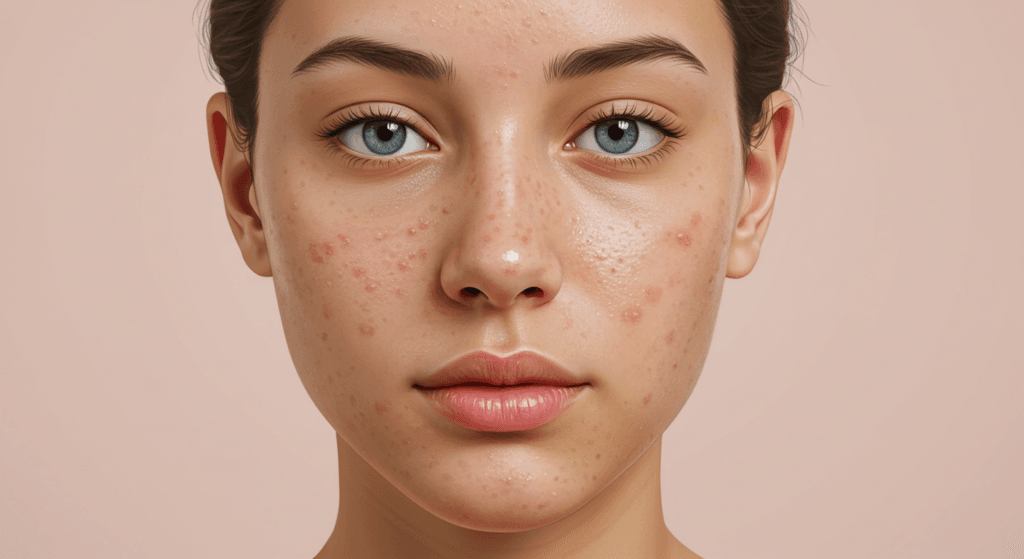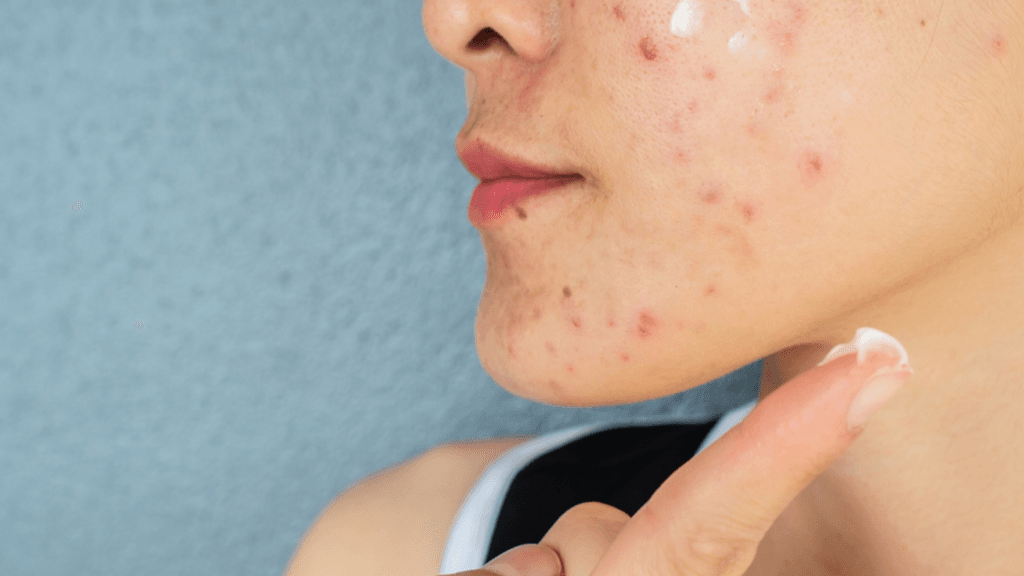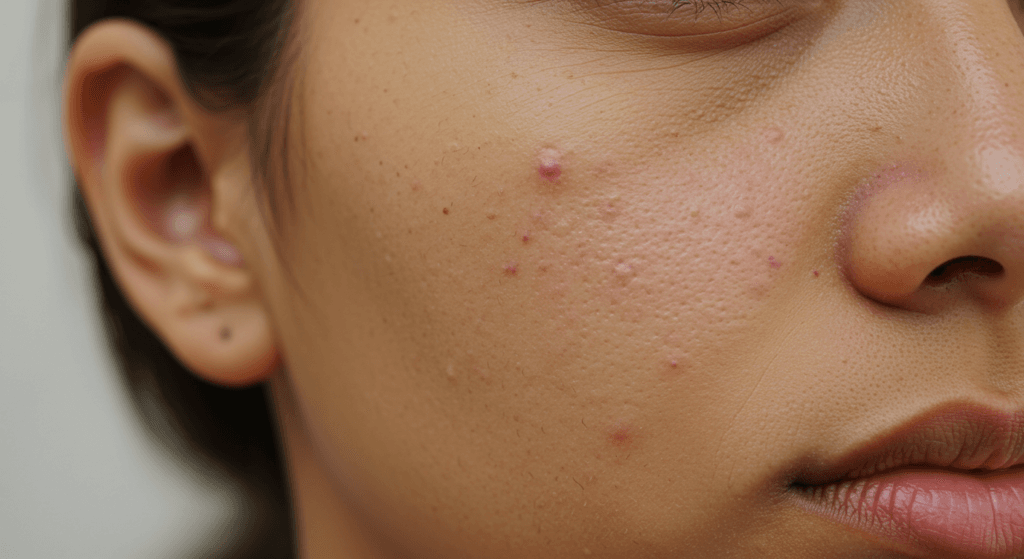Acne is a common skin condition that can be frustrating and persistent. While the root cause of acne involves clogged pores, inflammation, and the bacterium Cutibacterium acnes, hormonal fluctuations can also play a significant role in triggering breakouts. Understanding whether your acne is primarily hormonal or bacterial can provide valuable insights into managing it effectively. However, it’s crucial to remember that self-diagnosis can be tricky, and consulting a dermatologist is always the best course of action for personalized treatment.
That being said, there are some telltale signs that can offer clues about the underlying cause of your acne. Let’s explore the characteristics of both hormonal and bacterial acne.

Hormonal Acne: The Monthly Cycle Connection
Hormonal acne is often linked to fluctuations in hormone levels, particularly androgens (male hormones present in both men and women). These hormones can increase sebum (oil) production in the skin, leading to clogged pores and breakouts.
Key Characteristics of Hormonal Acne:
- Location: Hormonal acne tends to appear in specific areas of the face, primarily along the jawline, chin, and lower cheeks. It can also extend down the neck. This pattern is often a strong indicator of hormonal influence.
- Timing: Breakouts often coincide with hormonal shifts, such as:
- Menstrual Cycle: Many women experience hormonal acne that flares up a week or so before their period and subsides afterward.
- Puberty: The surge in hormones during adolescence frequently triggers hormonal acne.
- Pregnancy and Postpartum: Hormonal changes during and after pregnancy can lead to breakouts.
- Menopause: Fluctuating hormone levels during menopause can also contribute to adult-onset acne.
- Starting or Stopping Hormonal Birth Control: These medications can significantly impact hormone levels and may either improve or worsen acne.
- Type of Breakouts: Hormonal acne often manifests as deep, cystic breakouts that are painful to the touch. These are typically larger, red bumps that don’t come to a head easily. While whiteheads and blackheads can also be present, the deep, cystic nature is a hallmark.
- Age Group: While teenagers can experience hormonal acne, it’s also very common in adult women, often starting in their 20s, 30s, or even later.
Triggers for Hormonal Acne:
- Menstrual Cycle: The rise and fall of estrogen and progesterone levels throughout the menstrual cycle can significantly impact sebum production.
- Androgen Levels: An increase in androgens can lead to increased oil production and inflammation in the hair follicles.
- Polycystic Ovary Syndrome (PCOS): This hormonal disorder is often associated with hormonal acne, along with other symptoms like irregular periods and excess hair growth.
- Stress: While not a direct hormonal trigger, stress can affect hormone levels and potentially worsen hormonal acne.

Bacterial Acne: The Role of C. acnes
Bacterial acne, in contrast, is primarily driven by the proliferation of the bacterium Cutibacterium acnes (formerly known as Propionibacterium acnes) within clogged hair follicles. This bacterium thrives in the oily, oxygen-poor environment of a blocked pore, leading to inflammation and the formation of pimples.
Key Characteristics of Bacterial Acne:
- Location: Bacterial acne commonly appears in the T-zone (forehead, nose, and chin), as well as the cheeks. It can be more widespread across the face and may also affect the chest and back.
- Timing: Bacterial acne breakouts are generally less predictable and not as directly tied to hormonal cycles. They can be triggered by various factors.
- Type of Breakouts: Bacterial acne typically presents as whiteheads (closed comedones), blackheads (open comedones), and pustules (pimples with pus). While deeper cysts can sometimes occur, they are less characteristic of purely bacterial acne.
- Age Group: Bacterial acne is very common in teenagers due to increased sebum production during puberty, but it can affect people of all ages.
Triggers for Bacterial Acne:
- Excess Sebum Production: Oily skin creates a favorable environment for C. acnes to thrive.
- Clogged Pores: Dead skin cells and oil can block hair follicles, trapping bacteria inside.
- Inflammation: The presence of C. acnes triggers an inflammatory response in the skin.
- Hygiene and Skincare Habits: Factors like not cleansing the skin properly, using comedogenic (pore-clogging) skincare products, and touching the face frequently can contribute to bacterial acne.
- Environmental Factors: Heat, humidity, and certain medications can sometimes worsen bacterial acne.
Key Differences Summarized
To help you differentiate, here’s a quick comparison:
| Feature | Hormonal Acne | Bacterial Acne |
|---|---|---|
| Location | Jawline, chin, lower cheeks, neck | T-zone (forehead, nose, chin), cheeks, possibly body |
| Timing | Often linked to menstrual cycle, hormonal shifts | Less predictable, not directly tied to hormones |
| Type of Breakouts | Deep, painful cysts, can include whiteheads/blackheads | Whiteheads, blackheads, pustules (pimples with pus) |
| Age Group | Common in adult women, also in teenagers | Very common in teenagers, can affect all ages |
Can it Be Both? Absolutely!
It’s important to understand that acne can often be a combination of both hormonal and bacterial factors. For example, hormonal fluctuations can increase sebum production, creating a more hospitable environment for C. acnes to flourish, leading to bacterial breakouts in hormonally prone areas.
When to See a Dermatologist is Crucial
While these distinctions can be helpful, accurately diagnosing the primary cause of your acne and developing an effective treatment plan requires the expertise of a dermatologist. They can assess your skin, consider your medical history, and potentially recommend further evaluation (like blood tests in some cases of suspected hormonal imbalances).
You should consider seeing a dermatologist if:
- Your acne is persistent and doesn’t improve with over-the-counter treatments.
- Your acne is severe, with deep cysts or widespread breakouts.
- You suspect hormonal acne, especially if you have other symptoms like irregular periods or excess hair growth.
- Your acne is affecting your self-esteem or causing scarring.
General Treatment Approaches
Understanding the likely cause of your acne can guide treatment strategies:
- Hormonal Acne Treatment: Often involves addressing the underlying hormonal imbalances. This might include:
- Hormonal Birth Control: Can help regulate hormone levels in women.
- Spironolactone: An oral medication that can block the effects of androgens on the skin.
- Certain Topical Medications: Some topical retinoids can also be effective for hormonal acne.
- Bacterial Acne Treatment: Focuses on reducing bacteria and inflammation:
- Antibacterial Topical Medications: Like benzoyl peroxide and topical antibiotics.
- Oral Antibiotics: May be prescribed for more widespread or severe bacterial acne.
- Topical Retinoids: Help to unclog pores and reduce inflammation.
Conclusion: Listen to Your Skin and Seek Professional Advice
While there are clues to help you differentiate between hormonal and bacterial acne based on location, timing, and type of breakouts, it’s crucial to remember that acne is a complex condition with multiple contributing factors. The most effective way to determine the root cause of your acne and develop a personalized treatment plan is to consult with a board-certified dermatologist. They can provide an accurate diagnosis and recommend the best approach to help you achieve clearer, healthier skin.
Discover the expertise of Dr. Ebru Okyay, your trusted dermatologist in Antalya. Whether you’re looking to address medical skin concerns or enhance your natural beauty with cosmetic treatments, Dr. Okyay is here to help. With personalized care and advanced techniques, achieving your skin goals has never been easier.
